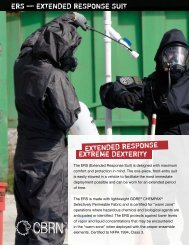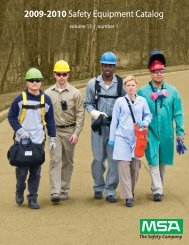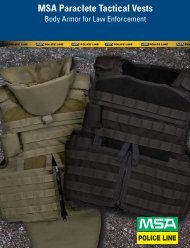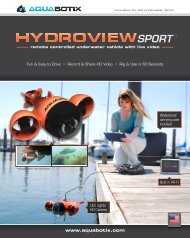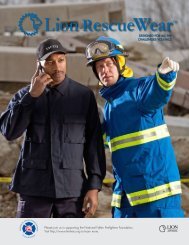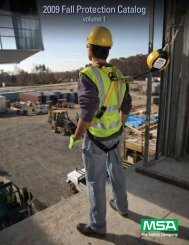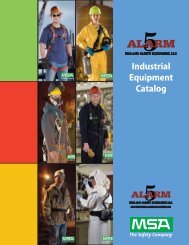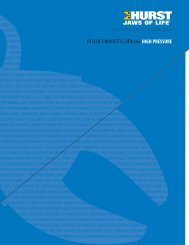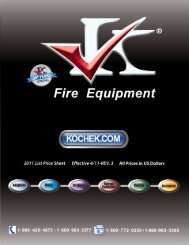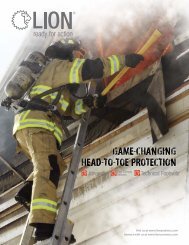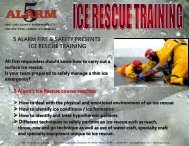EQUIPMENT FOR RESCUE aNd wORk aT hEIghT - 5 Alarm Fire ...
EQUIPMENT FOR RESCUE aNd wORk aT hEIghT - 5 Alarm Fire ...
EQUIPMENT FOR RESCUE aNd wORk aT hEIghT - 5 Alarm Fire ...
- No tags were found...
Create successful ePaper yourself
Turn your PDF publications into a flip-book with our unique Google optimized e-Paper software.
32 harnesses | Rappel BeltTesting | Harnesses 33Uniform Rappel Belt Designed for Emergency RappelUSA HUL Classified to NFPA 1983 – Escape BeltDesigned for everyday wear but with the performance needed for an emergency rappel or belay. Standard uniform wear for search and rescue, SWAT, andfire rescue personnel, the belt is constructed to the same exacting standards as our harness line and is the only certified uniform belt available. The tail endof the belt and the V-ring attachment point are secured out of the way with hook and loop. This belt is not intended as a substitute for a harness unless theoptional Leg Loops are used.Item # Color Size Waist* Weight Price202422 Black Small 26–32 in. (66–81 cm) 9 oz. (255 g) $39.00202423 Black Medium 30–36 in. (76–91 cm) 9 oz. (255 g) $39.00202424 Black Large 34–42 in. (86–107 cm) 10 oz. (283 g) $39.00202425 Black X-Large 40–48 in. (102–122 cm) 10 oz. (283 g) $39.00*Use regular pants sizes for waist sizesRappel Belt Leg LoopsUSA HThese quick attaching leg loops extend the versatility of the Uniform RappelBelt. More comfortable than a hasty harness tied out of one-inch tubular web,the leg loops allow you to turn your belt into a comfortable harnessfor that unexpected rappel or helicopter evacuation. Connect the steelHalf Moon Quick Link around the rappel belt to attach the leg loops in thefront. Hook-and-loop straps provide waist attachment points for the adjustingstraps at the back of the legs. Adjustable leg loops with leg pads providesuperb comfort. Includes Quick Link connector.Item # Color Weight Price202411 Black 1 lb. 9 oz. (709 g) with Quick Link $60.00www.cmcrescue.comCombining the Rappel Beltand Leg LoopsWhen used together, the belt passesthrough the Quick Link, which becomes theprimary attachment point for helicopterhoists or for emergency rappels.Harness StandardsProtect the RescuerWhen rappelling or litter tending, rescuers are usuallyalready at the “end of the rope” and not likely to fall.Working near an edge has fall potential; however, falls ofthe severity simulated in the standards seldom occur.This is particularly true with the NFPA 1983 requirementthat, after a head-up fall, requires that the harness besubjected to a second head-down fall.A rescue harness is tested to measure its performanceas a finished product. The static test applies loads to theattachment points on the harness to more than ten timesthe weight of a rescuer. Because the test is conducted inboth the normal head-up position and in a head-downposition, the harness demonstrates its strength no matterwhich direction the rescuer moves. The severity of thetest provides assurance that the harness will performexceptionally well under normal use.What is very difficult to incorporate into a standard is thehuman factor—the ease of donning and comfort. Throughexperience with our own harnesses and feedback fromour customers, we pay attention to donningand comfort in addition to building strength into ourharness designs.Drop Testing RequirementsHarnesses and escape belts are also required to pass a droptest for each attachment point. The test method uses a300-lb. (136-kg) manikin dropped 1 meter on a 1.2-metersteel lanyard. Each sample is tested with a head-up dropand a head-down drop.Static test of a CMC <strong>Fire</strong>-RescueHarness on a 300-lb. test torso.NFPA Standard 1983 Life Safety Harnessand Belt Performance RequirementsThe standard requires a static test and a drop test. Thestatic test differentiates between load-bearing attachmentpoints and positioning attachment points with differentload requirements for each. Where attachment points,such as shoulder or side D-rings, are intended to be used inpairs, the test is done in pairs.Static Test Requirements for Load Bearing Attachment PointsTest Position Class I Class II Class III Ladder Belt Escape BeltHead up 16 kN (3,597 lbf.) 16 kN (3,597 lbf.) 16 kN (3,597 lbf.) 13 kN (2,923 lbf.) 13 kN (2,923 lbf.)Head down None None 10 kN (2,248 lbf.) None NoneHorizontal None None None 10 kN (2,248 lbf.) NonePositioning attachment point requirements are 13 kN (2,923 lbf.) for the head-up test and 10 kN (2,248 lbf.) for a horizontal test.cmc rescue | 800-235-5741 | 805-562-9120Personal Gear Auxiliary Equipment Patient Care & Transport Systems & Kits Bags & Packs Anchor Devices Rope & Web Hardware Harnesses



